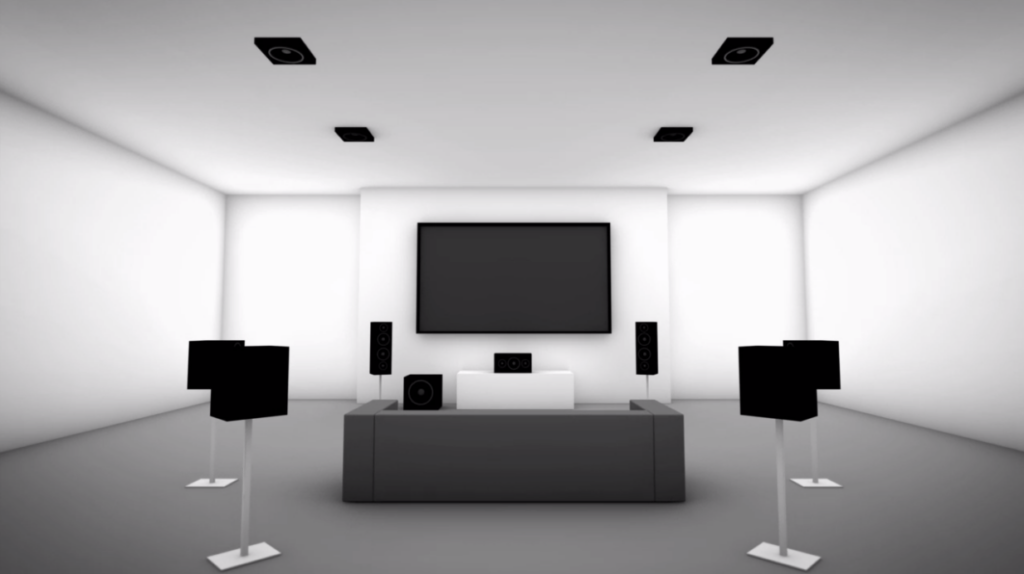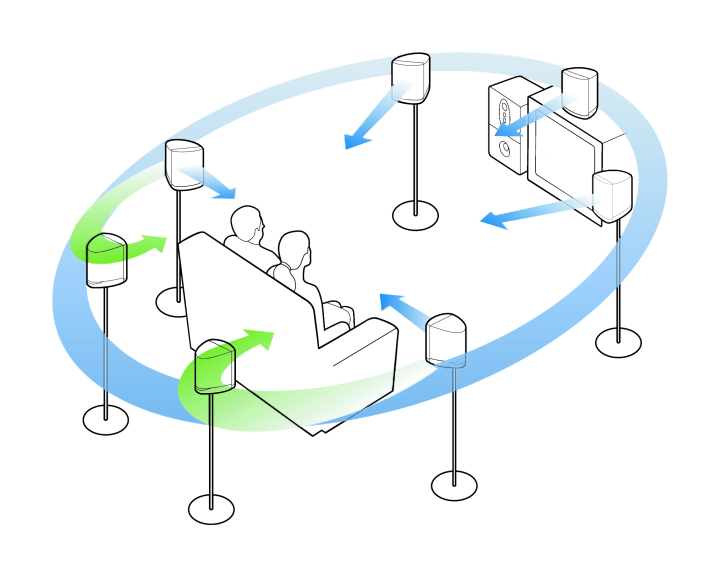Surround sound systems, in constant development since the 1940s, can now provide startlingly-realistic audio to home theaters or listening rooms. This is possible because as many as a dozen different sound channels can be encoded in a stereo signal, and then decoded to be sent to the proper speakers positioned around a central listening position.
Well, let’s get the smart-aleck answer out of the way quickly: it is sound which surrounds you.
Obviously, the real question isn’t what surround sound is. If you’re wondering about the technology, you’re more interested in how surround sound is created and what you need in order to experience it in your New York home theater or living space.
Here are the answers.

The Genesis of Surround Sound
In everyday life, not all of the sound you hear comes from directly in front of you. It comes from every direction. Even if you’re attending a concert, not all of the music you hear comes straight from the musicians on the stage. Some of it is reflected off of the walls, the ceiling, even the chairs and the people sitting in them. Finding a way to reproduce both the direct and reflected sound is what makes surround sound so challenging – and so rewarding.
Early attempts to create surround sound were highlighted by the Disney “Fantasound” technology which made the 1940s movie Fantasia such a stunning experience in theaters. A decade later, stereo sound was introduced and later became common in home and portable entertainment equipment. It was a step up, but still couldn’t duplicate a real listening experience.
The first real forerunner of surround sound was the quadraphonic technology of the early 1970s, which was somewhat similar to early versions of Dolby surround systems. However, it required extra receivers and amplifiers (which were still based on tubes instead of chips) so it was expensive, and manufacturers couldn’t agree on standards. It was only when Dolby created its surround sound process for blockbuster movies in the later 1970s that the technology finally became adaptable for home use.

How Surround Sound Works
In a nutshell, the original Dolby Surround recorded sound from the front center, left and right of an environment, plus sound from the rear. Those four channels were combined so they could be transmitted via a traditional stereo signal, and then were decoded at the receiving end to be sent to left, right and rear speakers (the center signal was a “phantom” one created from the left and right signals). It sounded better, but the rear sound reproduction wasn’t very realistic.
New iterations of the technology added extra speakers, greater channel separation and directionality, finally leading us to today’s advanced surround sound. Don’t let all of the formats like Digital, THX, EX, Pro Logic, Atmos, DTS and others confuse you. They all work on the same basic principle.
Most modern systems have four speakers in front of the central listening position: left, right, center and a subwoofer which reproduces low frequencies separately. There are then several “surround” speakers which are usually placed alongside but just behind the listening position, with some systems having even more speakers placed further to the rear. The numbers you often see like 5.1, 6.1 and 7.1 simply refer to the number of speakers; the first digit refers to the number of active speakers, while the “.1” refers to the subwoofer.
What makes this all work is the fact that today’s audio technology allows many different channels of sound to be encoded in a traditional “stereo” signal. That means producers can carefully determine the audio to be placed in each channel, and modern components can decode those signals to send a different audio track to each of the surround sound system speakers. In that way, the realistic audio effects of a concert hall, a gun battle or a plane soaring overhead – including the directionality as well as the ambient and reflected sound – can all be reproduced faithfully.
What Do You Need For Surround Sound?
Now that you understand the technology, you probably already know the answer to this question:
- One or more sources with the capability to receive and decode the surround sound signals which deliver audio to your speakers. This is most often a surround sound home theater or audio receiver, which can take the inputs from Blu-ray, DVD, cable or satellite inputs, decode them, and send the correct audio to each speaker. (Some people have separate processors or amplifiers for each channel, but that’s certainly not necessary).
- The correct number of speakers, positioned properly, to accommodate your system. A 7.1 surround system is the one most commonly chosen for new installations, because a major advantage of Blu-ray over DVD is that it supports 7.1 sound.
Want to look to the future? The newest technologies now make 9.1 and even 11.1 surround sound possible at the consumer level, making your home theater sound more like a movie theater than ever.
Contact us for a FREE consultation on how your living space can be set up with surround sound systems like the Polk Audio Blackstone™ complete with in-wall wiring, the top-rated Bose Acoustimass compact surround system, or one of the many outstanding Sony alternatives. We can also help with everything from TV mounting to complete home automation.









